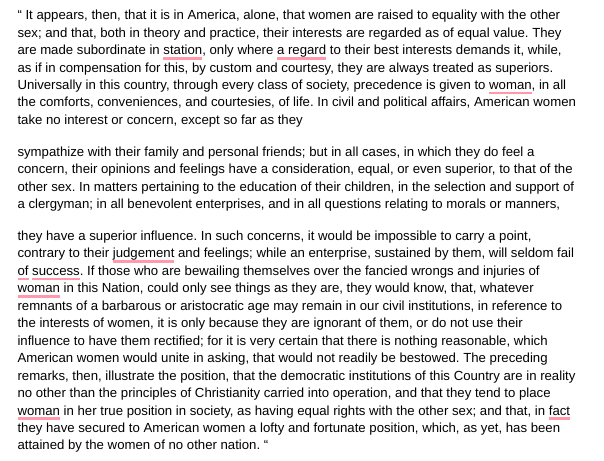OnRamps US History Unit 5 Test Review
0.0(0)
0.0(0)
Card Sorting
1/25
Earn XP
Study Analytics
Name | Mastery | Learn | Test | Matching | Spaced |
|---|
No study sessions yet.
26 Terms
1
New cards
The Second Great Awakening laid the foundation for?
Governing of self reliance and individualism, as well as several social reforms: Temperance movement, women's suffrage, prison reform, abolition, and labor laws
2
New cards
What were the 4 traits women were expected to display during the 1800's
Piety, submissiveness, domesticity, and purity
3
New cards
Define Piety
moral compass based on Christian values
4
New cards
Define submissiveness
Devotion to husband
5
New cards
Define domesticity
taking care of the matters at home
6
New cards
Define purity
Remaining steadfast to Christian beliefs and values
7
New cards
What is the essence of a Benevolent empire
To reach a society of perfectionism, life without sin
8
New cards
How did society react to majority of the reform movements
negatively, they were against reform movements that went against traditional norms
9
New cards
Who was blamed for Nat's Rebellion
Abolitionists
10
New cards
Why would it make sense for many in reform movements to convert to Quakerism?
Quakerism was the most inclusive denomination
11
New cards
What would be some of the consequences for people who bucked the traditions of society with various reform movements?
Death, which happened to Joseph Smith, or fleeing from death like Frederick Douglass. Women found it hard to find husbands and many wre shunned from churches.
12
New cards
Why does William Lloyd Garrison not want to tie himself to a political party?
Siding with a political party would automatically turn off half the country and therefore, not be open to his views and push for abolition
13
New cards
“In an address on slavery, I unreflectingly assented to the popular but pernicious doctrine of gradual abolition. I seize this opportunity to make a full and unequivocal recantation, and thus publicly ask pardon of my God, of my country, and of my brethren the poor slaves, for having uttered a sentiment so full of timidity, injustice and absurdity…”
What is the purpose of Garrison's statement above?
What is the purpose of Garrison's statement above?
He previously supported gradual emancipation, but it is not what he truly believes. Morally, the only right thing to do is to end slavery.
14
New cards
““Dear Mary,” said Harry — to his little wife, “I have a favor to ask of you. You have a friend whom I dislike very much, and who I am quite sure will make trouble between us. Will you give up Mrs. May for my sake, Mary?” A slight shade of vexation crossed Mary’s pretty face, as she said, “You are unreasonable, Harry. She is lady-like, refined, intellectual, and fascinating, is she not?”
What character trait of women is expressed here? (Fanny Fern Lesson 5.2)
What character trait of women is expressed here? (Fanny Fern Lesson 5.2)
Submissiveness to her husband's wishes
15
New cards

What is the argument laid out by Catherine Beecher in the document?
A woman's place is in the matters of domestic. In matters dealing with the house, women have superiority, but women don't belong in politics.
16
New cards
What two character traits that women are expected to possess link to Harriet Jacobs when she denies a house and a life of wealth from a former slaver?
Submissiveness and purity (TEST QUESTION)
17
New cards
What are the characteristics expressed in the "Cult of True Womanhood?"
Women were to remain pure, pious, submissive, and whose jobs are to be relegated to matter of the home (domestic).
18
New cards
“…every place that I visited gave fresh evidence of the fact that a greater revolution in public sentiment was to be effected in the free states- and particularly in New England- than at the South. I found contempt more bitter, opposition more active, detraction more relentless, prejudice more stubborn, and apathy more frozen, than among slave owners themselves…”
Which groups of people is the excerpt most likely referencing during the abolitionist movement
Which groups of people is the excerpt most likely referencing during the abolitionist movement
Poor and middle and middle class southerners who did not own slaves
19
New cards
Why would Garrison choose a backdrop like Bunker Hill to push abolition
Bunker Hill represented liberty and more specifically freedom and equality for "....all men..." and wanted to hold Americans accountable to the principles they set in the formation of this country.
20
New cards
How did Angelina Grimke establish credibility when addressing a Northern audience in her fight for abolition
She talked about her southern roots and experiences with slavery and its culture.
21
New cards
How does the New Testament describe the duties of women
Women are to be unobtrusive and private. They are to be calm and silent but strong in support of their husbands
22
New cards
What was the significance of the Seneca Falls convention of 1848
It produces the "Declaration of rights and sentiments" which declared that all Women as well as men were equal.
23
New cards
Who is Frederick Douglass
An escaped slave who educated himself, published many works detailing hor horrors in slavery and had to flee the country due to death threats
24
New cards

What movement does this picture represent
The Temperance movement
25
New cards
Who founded the Liberator Newspaper and what was his mission
William Lloyd Garrison, to end slavery
26
New cards
What is colonization
The notion to send slaves and former slaves back to Africa